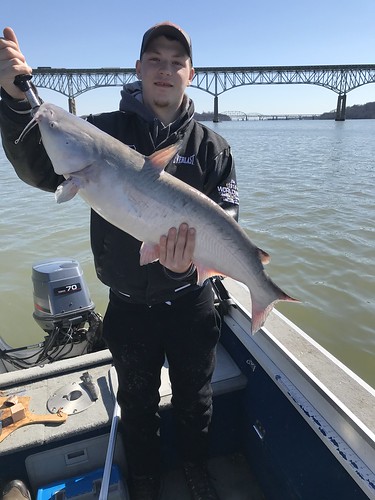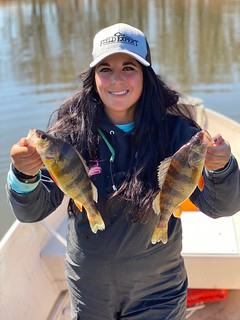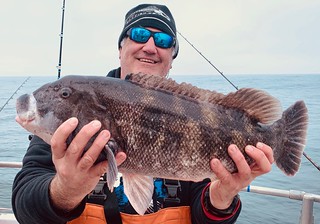Maryland Fishing Report – March 11

Julia Kennedy got to spend a fun afternoon fishing with her mom and sister on a sunny afternoon and caught her first bluegill sunfish. Photo by Carrie Kennedy
The signs of spring are everywhere and the warm sunny weather has families outside, enjoying the outdoors together. The Maryland Department of Natural Resources is busy stocking local waters with trout and all are preparing for the grand event — the traditional opening day of trout season at 5:30 a.m. on March 28. Local community ponds are an ideal place to enjoy family fun and get our younger anglers started. Bluegill sunfish have been the most common fish youngsters start out with, they are feisty and usually a sucker for a garden worm and bobber.
The Chesapeake Bay striped bass catch-and-release season is underway and will be open through March 31. Regulations can be found on the department’s website.
When using fish, crabs, worms, or processed bait, recreational anglers in the Susquehanna Flats and Northeast River may only use a circle hook, or “J” hook with a gap of less than or equal to 1/2 inch between the point and the shank. Eels may not be used as bait.
For trollers, stinger hooks are prohibited, barbless hooks are required, and no more than six lines are allowed while trolling.
The proposed summer-fall Chesapeake Bay striped bass regulations are in the scoping stage and comments are being solicited at this time. The comment period is open now and will close at 11:59 pm on March 18, 2020. Send your comments to the department by email to fisheriespubliccomment.dnr@maryland.gov or submit online.
And finally, our biologists have instituted several volunteer angler surveys to help them understand and better manage some of the important fish species to anglers as well as blue crabs and horseshoe crabs. This information is very important to the biologists who manage the species listed in the volunteer angler surveys.
Forecast Summary: March 11-17:
Expect air temperatures to bounce between the 50s and 60s by day and the 40s by night through next Tuesday. Windy conditions are expected Friday night, along with a chance of rain Thursday and Friday and again early next Tuesday. There will be partly sunny skies Saturday through Monday. These typical March conditions will continue to warm Maryland bay waters for gamefish such as yellow perch preparing to spawn.
As reported from the NOAA buoys, main bay surface water temperatures are holding at the mid 40s. However, smaller streams and downwind areas on a sunny day will warm faster and will often hold water temperatures in the upper 40s and low 50s. These water temperatures in low salinity areas will be prime spots to look for spawning yellow perch as they move up from their wintering areas in the downstream portion of rivers. In addition, in the main bay, there are still slightly warmer bottom waters so anglers may want to scan these areas for other gamefish.
The Maryland portion of the bay continues to have suitable oxygen conditions from surface to bottom. Bay surface salinities are normal for this time of year. Expect reduced water clarity in the upper Chesapeake Bay from the Aberdeen and Sassafras rivers to Swan Point, and on the Potomac River downstream to near the 301 Bridge. Expect normal flows to the rivers and streams entering Maryland’s portion of the Bay. There will be above average tidal currents conditions through Saturday as a result of the March 10 full moon.
For the full weekly fishing conditions summary and more detailed and up-to-date fishing conditions in your area of the bay, be sure to check out Click Before You Cast. Get regular updates on Maryland’s waters sent to your inbox with our Eyes on the Bay newsletter. Sign up online.
The lower Susquehanna River is providing a wide range of fishing opportunities. At the Conowingo Dam pool, large flathead catfish are being caught on cut bait. Smaller flathead catfish can be found below the dam pool along with medium-sized blue catfish. There are also some large blue catfish being caught just below the railroad bridge in a deep hole in the center of the river. Channel catfish are also very common in the lower sections of the river and the channels leading to the Susquehanna and Elk rivers.
Fishing for yellow perch in the lower Susquehanna River near Perryville continues to be good. Most are using dropper rigs baited with minnows or grass shrimp for the best results. As water temperatures warm up this week, yellow perch will be moving towards the Northeast River. The community park in the town of North East is an excellent place to fish for yellow perch from the floating docks there. Casting small shad darts tipped with grass shrimp is a good bet as is working a lipped hooked minnow along the bottom with a split shot about two feet forward.
Yellow perch can now be found in the Beachwood area of the Magothy River. There is a kayak launch and foot access off of Beachwood Park Road. It is a bit of a haul for a kayak but certainly possible. Others have had good luck putting on a pair of waders and walking out to fish the deeper areas of the channel. Casting small beetle spins, spinners or other small lures has worked well. and of course fishing with minnows or grass shrimp is always a good bet.
The Route 40 area of the upper Bush River is experiencing a run of yellow perch and will most likely taper off by the weekend. The yellow perch have arrived in the upper Chester River above the Route 290 Bridge and the Millington area and are providing plenty of fun fishing from small boats, kayaks, or shorelines. The Sassafras River is also experiencing a yellow perch run near the Route 301 area.
The upper Choptank and Tuckahoe rivers have been a major focus for yellow perch fishing. It started in earnest last Wednesday and continues today. Anglers are enjoying good fishing and the 2011 and 2015 year classes of yellow perch have been real standouts. The 2015 year class is generally measuring around 10.5 inches to 11 inches and many of them are males, so those wishing to throw back pre-spawn females can still fill their stringer with some nice male perch to take home. The 2011 year class of yellow perch are measuring 14 inches or more.
Casting small beetle spins, shad darts or spinners is a fun way to catch yellow perch. Minnows and grass shrimp on a bottom rig is a pleasant way to fish from shore. It has been interesting to see most bank fishermen now use metal stakes with a rubberized rod holder — which means no searching for a forked stick and it’s a lot more friendly to shoreline bushes and saplings.
The yellow perch spawning runs are beginning to slow down, which gives anglers the chance to catch post-spawn yellow perch as they descend from the spawning areas. White perch are not far behind and can now be found in the deeper waters in the middle regions of the Choptank River. Grass shrimp and pieces of bloodworm are good baits to use when fishing deep for white perch. Fisheries biologist Paul Piavis reports that surveys revealed large white perch are staged above the Dover Bridge area of the Choptank River.
At present yellow perch can be found from the Greensboro area up to the Goldsboro area. A variety of small lures fished close to the bottom are working well, as are bottom rigs baited with minnows or grass shrimp. White perch are being caught in the Denton area this week by those fishing pieces of bloodworm on bottom rigs.
Fishing for northern snakeheads has shifted into a higher gear as sunny days begin to warm the waters of lower Dorchester County. Anglers have been using various-colored swimbaits with good success casting in open waters and along shorelines. Casting bobbers and popping corks that are trailing large minnows is also a productive way to fish for northern snakeheads. Often one can be actively casting lures towards shoreline structure or emerging grass beds and dead stick a minnow under a bobber out in more open water. One must keep glancing over at that bobber.
Fishing for blue catfish is good in the Choptank River in the general vicinity of the Dover Bridge. Shore-based fishermen have a new fishing access on the east side of the old span. It is a great place to fish for blue and channel catfish as well as white perch. There are six parking spots plus a handicap parking spot and a paved walkway to the old bridge span. One can fish off the old east side and it is handicap accessible. This is a real gift for anglers from the state highway department, so let’s try to keep it trash free and pick up any litter you happen to see. The west side of the old bridge span is off-limits to the public. To learn about other fishing access points in Maryland be sure to check out the Fisheries Access Map.
There is plenty of fishing action in the Nanticoke River and Marshyhope Creek this week. Fishing for yellow perch continues to be good in the Marshyhope upstream towards Federalsburg. Most are having good success with a variety of small lures or fishing with bottom rigs baited with minnows or grass shrimp. Those fishing bottom rigs baited with grass shrimp or pieces of bloodworm are catching a few white perch which are making up the vanguard of the upcoming white perch spawning run.
Yellow perch fishing in the upper Patuxent River from Jug Bay up past the Route 4 Bridge continues to be good. The Allens Fresh area of the upper Wicomico is a traditional area to intercept spawning yellow perch and the surge of yellow perch through the area is not disappointing anglers.
Fishing for blue catfish in the Nanticoke River in the general area from the Sharptown Bridge down to the mouth of the Marshyhope offers some exciting fishing action this week. Most successful anglers are using fresh cut bait when fishing for blue catfish. Gizzard shad are often the most popular bait, but fresh white perch works well also. Large minnows make an excellent bait for the medium sized blue catfish and some report having good luck with wild shrimp from a seafood market or chicken liver. Channel catfish will certainly be in the mix.
Another fish that inhabits the depths of the lower Marshyhope and the Nanticoke River is a very primitive species known as the longnose gar. They have a formidable set of teeth and often are very hard to hook when fishing lures or cut bait. Samson Matthews was fishing with his friends below the Eldorado Bridge on Marshyhope Creek last week for blue catfish when he hooked up with an 18.3-pound longnose gar, establishing a new state record for the species.
There certainly are a lot of blue catfish in the region and from an environmental perspective we sure wish they were not as prolific as they are. The aquatic world in Maryland is most likely going to look far different in the next decade in regard to biodiversity in our river systems due to the expansion of invasive species. Blue catfish, flathead catfish, and northern snakeheads offer fishing with no creel limits, no season and no minimum size. The medium-sized blue catfish make excellent table fare, the meat is white and firm and freezes well. Flathead catfish and northern snakeheads make excellent table fare as well.
The blue catfish fishery in the tidal Potomac and Patuxent rivers is well established and many locals have discovered the food resource that it can provide. The medium-sized blue catfish can be found in large numbers along channel edges of the Potomac River from the Wilson Bridge down river to the Bushwood area at the mouth of the Wicomico River. The general areas above and below the Route 231 Bridge on the Patuxent River tends to offer some of the best fishing for blue catfish. Trophy seekers are usually seen fishing the deepest and swiftest waters off Fort Washington for blue catfish that can exceed 80 pounds.
Fishing for northern snakeheads is gaining steam in the tributaries of the Potomac River this week. Warm, sunny weather is warming up the waters in creeks and rivers and northern snakeheads are becoming more active. Perhaps one of the most effective and popular lures to use this time of the year is a white swimbait, while doing that, it is a good option to be fishing a large minnow under a bobber nearby.
Crappie fishing is very good this week in the tidal Potomac near marina docks, submerged rubble, and fallen treetops. The crappie are generally holding in about 5 feet of water and can be caught on small minnows or marabou jigs under a slip bobber.

Charlie Dolan holds up a beautiful walleye for the camera before slipping her back into the river. Photo by John Mullican
The preseason stocking of trout continues this week in the Closure 0 areas with generous stockings of rainbow trout. The Closure 1 areas are now closed until March 28, which is the traditional opening day of trout season. Closure 2 areas will close March 22 and also reopen at 5:30 a.m. on March 28.
The trout hatchery staff and stocking crews have been working tirelessly through the year to bring Maryland trout anglers the best trout possible, and we are ready for a classic opening day.
This is certainly a good time to check your fishing gear, but more importantly get your younger anglers ready and for those dealing with an empty nest or not quite there with children of your own, try and gather up some of the kids in the neighborhood or those of a relative and take them trout fishing. Stocked trout are an ideal way to introduce our younger anglers to fishing whether it is a river, creek or local community pond that has been stocked, there are opportunities for all levels of angling ability. The online spring trout stocking schedule will let you know where, when and how many trout are being stocked at various locations and the map section will guide you to those areas.
Fishing for smallmouth bass and walleye in the upper Potomac has been good recently and this weekend will be a great time to venture out on the river or to fish along the shorelines or at one of the dams. Small crankbaits cast near emerging grass, submerged ledges or rocks is a good way to fish for smallmouth holding in shallower waters. Using jigs, tubes, small deep diving crankbaits and grubs are a good way to target the deeper waters for a mix of smallmouth bass and walleye.
Largemouth bass are reacting to warming water temperatures this week and can often be found in transition areas between deeper waters and the shallower areas where grass is beginning to emerge. When fishing these transition areas, which are usually about 5 feet deep, small crankbaits, grubs and soft plastics are a good bet. If you spot any kind of submerged structure such as sunken wood, they are excellent places to target. Shallow waters will often warm towards mid-day and largemouth bass will wander into these areas looking for prey. Spinnerbaits are a good way to cover water in these shallower areas.
Farm ponds are often real honey holes when it comes to largemouth bass and most often they will still be found in the deeper parts of the ponds. Small crankbaits and soft plastic baits are a great way to cover these locations. Fallen tree tops are also a good place to look for largemouth bass whether in a tidal creek, reservoir or farm pond. Farm ponds and impoundments can offer excellent crappie fishing this time of the year and can be found holding near structure in about 5 feet of water. Small minnows or marabou jigs under a slip bobber is a good way to catch them.
Chain pickerel are active this week and will provide plenty of entertainment in tidal waters or nontidal waters. They will be found holding near shoreline structure waiting to ambush anything that happens to come by. Most any kind of lure works for chain pickerel, and single hooks can be a real asset when trying to unhook one, and they are gentle on the fish since they tend to inhale baits deeply.
The best action going on in the Ocean City area continues to be the outstanding tautog fishing at the offshore wreck and reef sites. When weather conditions are favorable, anglers fishing on the charter and party boats out of Ocean City are catching some very large tautog.
“I’m getting flak from the standard angler crowd — you know, that group that just…throws some food around and hopes the fish is hungry.“–Dutch Baldwin, previous state record holder for northern snakehead, which was shot with a bow and arrow.
Maryland Fishing Report is written and compiled by Keith Lockwood, Maryland Department of Natural Resources fisheries biologist.
Click Before You Cast is written by Tidewater Ecosystem Assessment Director Tom Parham.
This report is now available on your Amazon Echo device — just ask Alexa to “open Maryland Fishing Report.”






 1-888-373-7888
1-888-373-7888 233733
233733